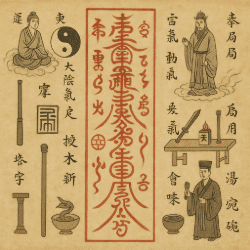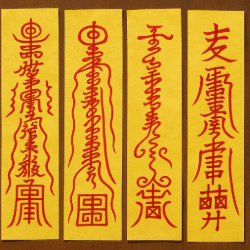Taoism is often introduced to the world as philosophy or gentle exercise. Yet within its temples and mountains lies another stream—Taoist magic. This stream is old, layered, and alive. It carries with it rituals, talismans, chants, and visions meant to bridge the seen and unseen. For some it is superstition. For others, it is a science of the sacred.
This page is a complete guide to Taoist magic, serving as a hub for deeper topics. Here you will find history, symbols, practices, and common questions—all arranged so you may follow what interests you further.
What Is Taoist Magic?
At its heart, Taoist magic is the applied side of Taoist spirituality. Where Taoist philosophy speaks of balance and the Tao itself, Taoist magic works with the currents of qi, spirits, and symbols to bring about change.
It may be used to heal the sick, protect the living, summon rain, drive away demons, or bless crops. In other words, it turns doctrine into ritual power.
Key features:
Works with qi (life force) and cosmic rhythms.
Uses talismans (fu), chants, hand seals, and ritual tools.
Connects practitioner with spirits, deities, and natural forces.
Can be either private (household) or public (temple).
A Brief History of Taoist Magic
Taoist magic did not appear in a single moment. It grew, like a vine along stone, across centuries.
Classical Roots (pre-Han): Ritual masters used early charms, divination, and healing rites.
Han Dynasty: The Taiping Jing and other early texts linked cosmic order with human ritual.
Mao Shan Tradition (4th century): Introduced detailed talismanic practices and the “Ching scale”—a descent of sacred power from pure heavens into ritual symbols.
Tang and Song Dynasties: Magic became systematized. Ritual manuals, thunder rites, and celestial invocations spread.
Later Taoism: Sectarian schools blended folk practices, Buddhist influence, and inner alchemy.
Modern Taoism: Taoist priests in China, Taiwan, and beyond still perform rituals for healing, exorcism, and blessing.
The Ching Scale and Descent of Power
In Episode 1-141 of Living the Tao, Master Steenrod described the Ching scale—a concept from Mao Shan Taoism.
This scale describes how cosmic energy differentiates as it descends from formless Tao into form. Each stage of descent creates symbols, incantations, and talismans. When a priest draws a talisman or speaks a chant, they are aligning with a rung of this scale.
Comparisons:
Classical Taoism: spoke of Tao generating the One, the Two, the Ten Thousand Things.
Mao Shan Taoism: gave a more detailed ladder, linking ritual symbols directly to cosmic descent.
Four Ascendant Tradition: teaches a similar multi-layered purity, overlapping with Mao Shan ideas. However, the 4AS lacks the Divine Bureacracy and takes a completely energetic view of the Ching.
This blending of metaphysics and ritual is what makes Taoist magic distinct. It is not only performance; it is cosmic participation.
Taoist Talismans (Fu 符)
Talismans are the most recognizable face of Taoist magic. They are written, burned, drunk as ashes mixed with water, or worn as amulets.
Drawn in red or yellow ink on paper or wood.
Contain mystical characters, diagrams, and seals.
Each is believed to anchor a divine force or command a spirit.
Used for healing, protection, exorcism, safe travel, or success.
Talismans often appear mysterious, but within Taoist ritual they are precisely constructed. Each stroke, each curve, is part of the descent of Ching.
Ritual Practices in Taoist Magic
Taoist ritual is broad, but some core practices stand out:
Healing Rituals – calling on deities, using talismans, and guiding qi.
Exorcism – driving away ghosts or malevolent forces with chants, bells, and swords.
Weather Magic – petitions for rain or protection from storms.
Blessings and Protection – rituals for households, marriages, and journeys.
Funerary Rites – guiding the dead to the next world.
Each ritual has choreography: the use of mudras (hand seals), specific chants, and the placement of tools.
Tools and Symbols of Taoist Magic
Common ritual implements include:
Altars with offerings.
Ritual swords (often made of peachwood or bronze).
Bells and drums to summon spirits.
Registers (lists of divine names).
Incense as a medium of offering.
These are not props. In Taoist thinking, they are bridges—each tool resonates with a force in the cosmos.
Deities and Spirits in Taoist Magic
In the Mao Shan tradition, Taoist magic operates within a cosmic bureaucracy:
The Jade Emperor – celestial ruler.
Thunder Gods – enforcers of cosmic order.
Stellar Deities – linked to constellations.
Local Earth and River spirits – guardians of place.
Immortals and Ancestors – intermediaries for human needs.
Invocations often read like official documents, summoning divine aid through ritual petitions.
Taoist Magic vs Other Traditions
Taoist magic is not unique in the human story. Similar practices exist in other traditions, though expressed differently.
Buddhist Esoteric Rituals (Tantra): mantras, mandalas, and deity invocations.
Western Ceremonial Magic: talismans, sacred words, ritual implements.
Folk Magic: charms, amulets, ancestor petitions.
The difference is that Taoist magic is tied deeply to the Taoist cosmology—qi, Tao, and the cycles of yin-yang.
Modern Taoist Magic
Today, Taoist magic survives in both temple rites and folk practice. In Taiwan, Hong Kong, and mainland China, Taoist priests are still called to bless homes, heal, or conduct exorcisms. In diaspora communities, Taoist talismans circulate as protective charms.
In the West, Taoist magic is often studied through translations, workshops, or online courses. Some adopt it as practical ritual, while others see it as symbolic psychology.
Misconceptions about Taoist Magic
Because the word “magic” carries weight, many questions arise.
Is Taoist magic superstition?
Not in its own context. It is structured, systematic, and tied to a long cosmology.Is it only about spells?
No. Taoist magic is also about healing, community, and cosmic balance.Does it contradict Taoist philosophy?
Classical Taoism emphasized non-action (wu wei). Taoist magic channels that principle—ritual action harmonized with cosmic order.
Closing Reflection
Taoist magic is not a curiosity from the past. It is a living current. To study it is to glimpse how Taoism has always been more than words. It is the art of inscribing the cosmos into paper, breath, and ritual.
Like a river, Taoist magic divides into many channels—sectarian, folk, modern. Yet each returns to the source: the Tao, ungraspable and whole.


